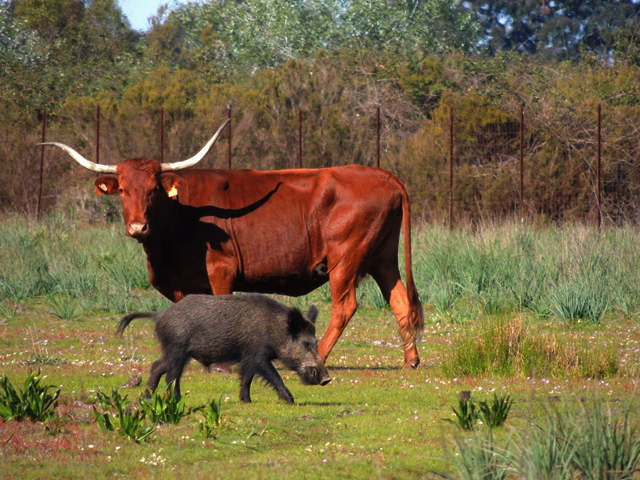Controlling infections shared by wildlife and livestock requires the understanding and quantification of interspecific interactions between the species involved. This is particularly important in extensive multi-host systems, in which controlled domestic animals interact with uncontrolled, abundant and expanding wild species, such as wild ungulates. The interspecific interactions between wild boar and freeranging cattle were quantified in Mediterranean Spain, along with their spatio-temporal variability. GPSGSM- collars were used to monitor 12 cows and 14 wild boars in the Doñana National Park between 2011 and 2013. Interactions were defined as encounters between cattle and wild boar within a spatio-temporal window of 52 m and 1 hour. On average, each wild boar interacted with one cow 1.5 ± (SE) 0.5 times per day, while each cow interacted with one wild boar 1.3 ± 0.4 times per day. The frequency of interaction was significantly higher during crepuscular hours owing to the overlap of both species' activity, and also during spring and autumn, probably owing to a higher individual aggregation around shared resources. Finally, the frequency of interaction was higher near the most significant shared resources (e.g. water points) but was lower in areas with dense vegetation. The results presented here show the usefulness of GPS monitoring as regards quantifying interactions and helping to clarify the process of pathogen transmission at the wildlife-livestock interface in Mediterranean Spain, along with the main spatio-temporal risk factors. In a changing scenario in which European populations of wild ungulates are increasing, more efficient measures with which to control interactions are required to meet the demands of farmers and managers. These results, therefore, provide directional hypotheses that could be used to design disease control programmes. informacion[at]ebd.csic.es: Triguero-Ocaña et al (2019) Spatio-temporal trends in the frequency of interspecific interactions between domestic and wild ungulates from Mediterranean Spain. PLoS ONE https://doi.org/10.1371/journal.pone.0211216
https://journals.plos.org/plosone/article?id=10.1371/journal.pone.0211216

 Las altas temperaturas están provocando que las lagunas y las marismas de Doñana pierdan agua rápidamente
Las altas temperaturas están provocando que las lagunas y las marismas de Doñana pierdan agua rápidamente




